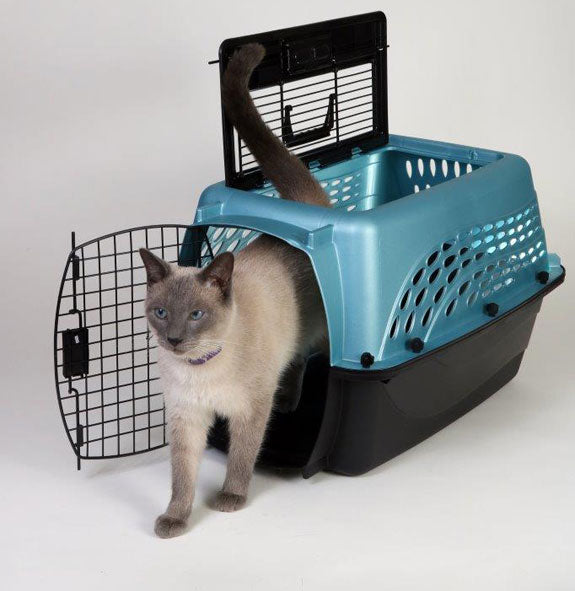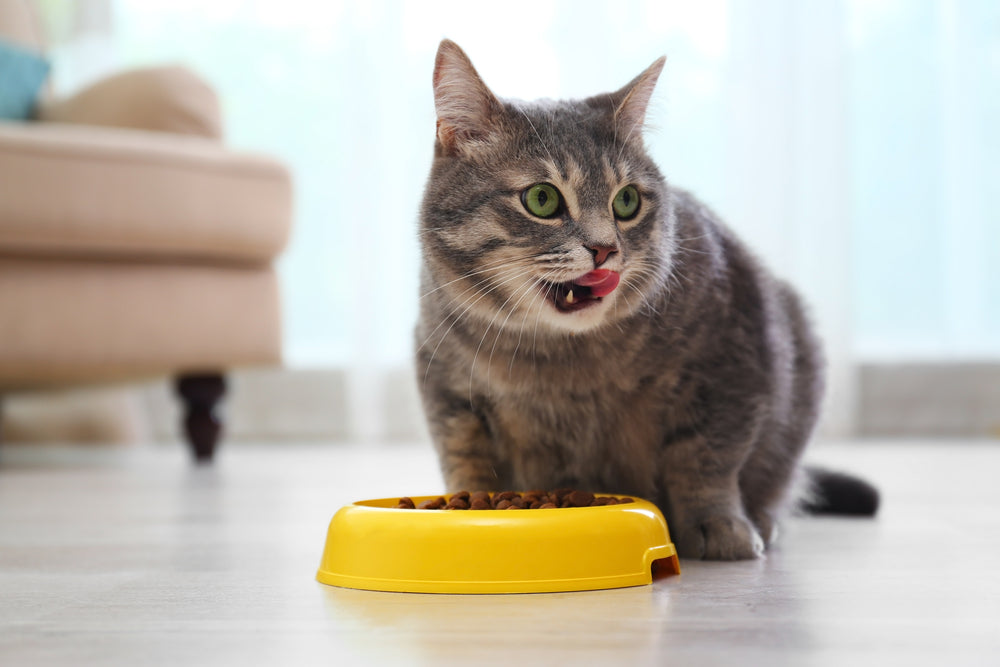Turning the Cat Carrier into a Cat-Tastic Place To Hang Out In & Enjoy During Travel

This article was written by feline health and behavior expert, Dusty Rainbolt. She is the award-winning author of Cat Scene Investigator: Solve Your Cat's Litter Box Mystery, Finding Your Lost Cat: The Practical Cat-Specific Guide for Your Happy Reunion, and Kittens for Dummies. She is a feline behavior consultant, the past president Cat Writers' Association, and has been an in-the-trenches cat and kitten rescuer for over three decades. You can learn more about her at: www.dustycatwriter.com
When the carrier comes out, does your cat perform a disappearing act that Houdini would have envied? That's not surprising if the only time he sees the carrier is when you take him to the vet. As cat owners, we should take a look at the carrier (or, as Fluffy calls it, the Evil Vet Transportation Box) from his perspective.
Let's travel back in time to your preschool years. Your mom has a pink car she only drives when she takes you to the doctor. She chases you around the house and forces you into the pink beast. The doctor's waiting room smells like antiseptic. Suddenly, a six-foot-tall, heavily tattooed gang member gets in your face and yells, "You lookin' at me?" The examination table feels like ice. The nurse shoves a thermometer up your butt. The doctor pokes you with needles. And that's a routine visit. If you're sick, it's way worse. From now on, any time you see the pink car, you know it's going to be a bad day.
That's basically what your cat experiences, except the car is his carrier and the gang punk is really a German Shephard. To your cat, it's a horrifying and stressful experience.
YOU CAT'S RELATIONSHIP WITH HIS CARRIER MAY AFFECT HIS HEALTH
Statistically, cats are far less likely to have routine veterinary visits than dogs, partly because of the stress caused by the ride in the Evil Vet Transportation Box, and partly because of stress at the clinic. Without routine exams, serious illnesses may not be detected until they're quite advanced when treatment is more invasive and costly.
THE PARTY BOX
In this second-time travel scenario, your mom opens the pink car's door. "Wanna go for ice cream?" Next time, it's, "Let's go to the beach!" You find some fluffy blankets and snacks in the back seat. you take a nap. You play video games. you get to build sandcastles! A month or so later, she says, "Let's go for a ride." That trip ends at the pediatrician's office. After you experience all the unpleasant stuff, the doctor gives you a lollipop and Mom takes you for ice cream.
When Mom made it fun, you changed the way you looked at the pink car. That's what we need to do with your cat's carrier – change his perspective of it from the Evil Vet Transportation Box to the Party Box.
CATS ARE PREY
Most of Fluffy's anxiety comes from his precarious link in the food chain. In the wild, domestic cats are prey to larger carnivores; dogs, coyotes, foxes, and even malicious people. From Fluffy's perspective, that dog barking in the waiting room wants to eat him. (He may not be wrong about that.) He also views the vet and vet techs as predators too..
RECONCILING A CAT WITH THE EVIL BOX
Despite a rocky past history, it's never too late to start acclimating Fluffy to the carrier. If you have a veterinary appointment scheduled, start reintroducing him to the carrier two to three weeks beforehand.
Dismantle your cat's carrier and set out the bottom half where the cat likes to hang out. Make it an inviting place. Place his favorite bed or a soft towel inside. Begin to feed him inside the carrier. Toss his favorite treats in occasionally or sprinkle some catnip inside the bedding. Whenever you see him in or near the carrier, praise him. Plus, it's treat time!

After he begins to spend time in there, put the top on the carrier but without the door. When that goes well, completely assemble the carrier. Keep the bedding in place. Secure the door in the open position to allow him to come and go at will. Continue feeding in the carrier and leave treats and toys inside.

Now that he feels comfortable sleeping in the carrier, it is time to acclimate him to transport. Break the trip into baby steps, offering treats and praise with any success. When he's comfortable with one step, move to the next.

- On an empty stomach, let Fluffy watch you put some treats in the carrier. When he enters to get his treats, close the door. Toss in some more treats. Carry the crate around the house. Stop for a moment. Praise him and give him a treat. Then set him free. Do this for a longer period each session.
- When moving the carrier, carry it level. If you're using a soft-sided carrier, don't carry it by the shoulder strap as that tilts it at an angle and smashes him into the walls. If you're using a plastic carrier with a handle, still refrain from using it. Instead wrap your arms around the top and bottom of the carrier, and hold it steady like that. Some handles wear out over time and could break off, especially if your cat has gained weight.
- Take short trips in a car or walk around the block. Once in the car, play soft music. Again, more treats. Visit pet-friendly businesses such as Petco, PetSmart, Lowe's, Home Depot, and Starbucks. Leave Fluffy in the safety of his carrier, but allow people to ooh and ahh over him. Let them offer treats. (Most Starbucks locations offer a Puppucino for free upon request. It's an espresso-shot-sized paper cup full of whip cream. One Kitticcino, please.)
THE DAY OF THE APPOINTMENT
- Withhold food for two to three hours before loading the cat into the carrier. This reduces the change of motion sickness and makes treats more desirable bribes. If he becomes nauseous every time he rides in the car, ask your vet about giving him anti-nausea medication before the appointment.
- 15 to 30 minutes before loading him in the carrier, spray the interior and bedding with Feliway feline facial pheromone. This allows the alcohol in the solution to evaporate. Feliway is an analog of a cat's comforting facial pheromone. This is a friendly pheromone that cats recognize as their own scent. Research shows the presence of Feliway makes a new place or situation feel far more familiar and safe for cats.
- Cover the carrier with a towel that smells like home. It blocks the scary sights and activity happening outside the carrier and masks external odors. Or use a towel sprayed with Feliway pheromones, which have a calming effect in addition to masking the scents of other animals.
- Don't forget his treats.
If Fluffy won't enter the carrier voluntarily, spread out a large towel where he normally rests. Gently place him in the center of the towel. Bring the corners and sides together, create a bag, and put the cat in the carrier wrapped inside the towel.
PANDEMIC PROTOCOLS

Under normal circumstances, there are things you can do to reduce Fluffy's fear and stress when you accompany your cat into the clinic. Unfortunately, veterinary hospitals have been given specific protocols to follow during COVID-19, including curbside pickup of patients. Since owners are not allowed to enter the clinic with their pets, I will provide these suggestions in a future article, when life returns to a semblance of normal. Until then, here are some suggestions to reduce Fluffy's stress when you can't accompany him into the clinic.
- Use a top-loading carrier with a door in the roof. Top access makes removing and loading a reluctant cat much less stressful. When a cat arrives in a front-loading carrier, staff may be tempted to turn it on the end and dump him out.
- When you set Fluffy's appointment, ask if you can schedule his visit on a dog-free day or a cat-only morning.
- Bring Fluffy's own toys from home that staff can use as a distraction. Veterinarians don't want to use communal cat teasers and toys because of the potential to spread germs. Label the wand with your name, so you can get it back.
- Take your cat's favorite blanket or a towel that smells like home to be put in with him in the carrier.
By changing Fluffy's perception of the carrier, you're setting the stage for a much less stressful clinic experience for both of you.
Happy traveling!
Previous article

Next article

Related posts
View all-

Wet Vs. Dry Cat Food: Which is Better?
As a caring cat owner, you always want the best for your furry friend, especially with their food. You typically have two choices: dry cat food in a bag or canned wet food. Whether you've just brought home a new kitty or are looking to transition to a new food, the decision process can be overwhelming, and understanding the impact of each on your cat's diet is essential. Read Article -

Celebrate National Pet Week: Fun Ideas to Celebrate with Your Pet
National Pet Week is right around the corner, so it's time to plan how you're going to celebrate! While we're sure you celebrate your pet all day every day... Read Article -

5 Simple Tips to Make Sure Your Cat Drinks Enough Water
Ensuring your cat stays hydrated is important, but it can be challenging since many cats don't drink enough water. Dehydration can lead to kidney disease and other health issues. Fortunately, you can encourage your cat to drink more with a few simple changes. Read Article



